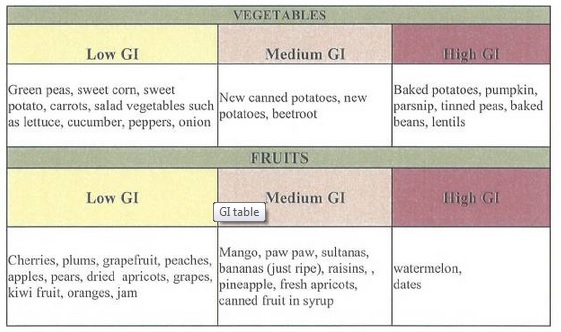What is Glyceamic Index (GI)?
In recent times there has been a lot of attention on the role of glycaemic index in our diets. There is some evidence to suggest that a low glycaemic index diet can help with weight loss, protect against cardiovascular disease, Type 2 diabetes and obesity.
Glycaemic Index (GI) is a way of ranking carbohydrate foods based on the rate at which they raise blood glucose levels. Foods that are digested quickly will raise blood glucose levels quickly and therefore are given a high GI value, while foods that have a more gradual effect on blood glucose levels will have a medium or low GI value.
Everyone with diabetes is aiming for this slow gradual rise in blood glucose levels rather than a sudden peak, therefore avoiding high sugar foods will prevent the peaks of high blood glucose levels while choosing low GI foods can help with keeping hunger a bay and help with blood glucose control. Even cooking can affect the GI value, for example raw carrot will have a lower GI value than cooked carrots.
What role does GI play in weight loss?
Firstly remember that all fruits and vegetables will be low in calories, high in fibre and full of vitamins and minerals so choosing any fruit or vegetables will always be a healthy choice. If you want the added benefit of ones that are more filling and therefore more satisfying then go for the low or medium GI ones. Any attempts at weight loss must always include low fat foods, reduced portion sizes and as much physical activity as possible. GI only plays as small part in the over all plan for weight loss.
What role does GI play in Diabetes?
Again remember that all fruit and vegetables will be low in calories, high in fibre and full of vitamins and minerals so choosing these instead of high sugar, high fat snacks such as biscuits, crisps etc will always be the better option. People with diabetes do need to remember that all fruit contains natural fruit sugar so while all fruits are suitable for those with diabetes, you just need to pay attention to how much you have at one time. One portion of fruit is enough at one time. See portion sizes for information on a portion of fruit.
All vegetables are suitable for people with diabetes and will have little or no affect on blood glucose readings (with the exception of those listed in the high GI section). This doesn’t mean that people with diabetes shouldn’t include fruit and vegetables with a high GI they simply should be aware that these particular fruits and vegetables will raise the blood glucose levels quicker than other fruit and vegetables. This might explain the unexpected high blood glucose reading you might sometimes get if you had watermelon for dessert, or a very ripe banana.
Also somebody that has for example grilled salmon with pasta with peppers, onion and salad for dinner today might have very much lower blood glucose levels compared to the day they have potatoes with processed peas and grilled salmon. The pasta and salad will have a lower GI and therefore a more gradual affect on blood glucose than the potatoes and processed peas which will have a high GI.


